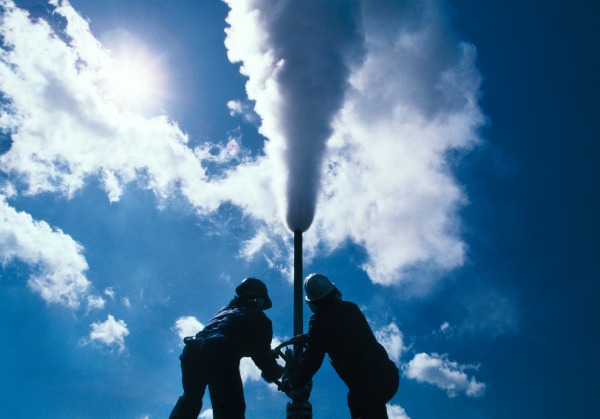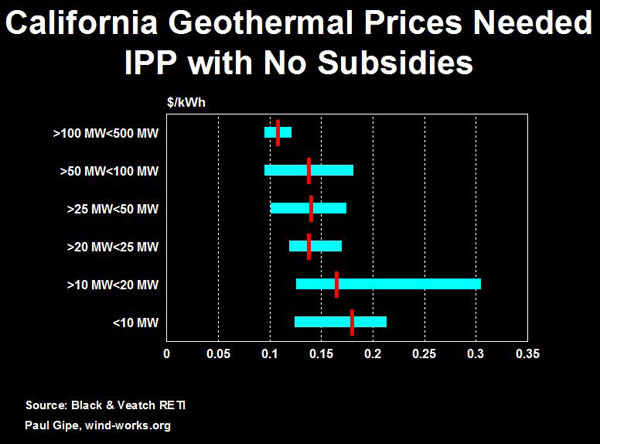 With the right policies in place, geothermal could play an active role in reaching California’s renewable energy goals.Small, geographically dispersed geothermal power plants could provide 7 percent of California’s electricity supply, according to an analysis of data collected by a consultant to the Golden State.
With the right policies in place, geothermal could play an active role in reaching California’s renewable energy goals.Small, geographically dispersed geothermal power plants could provide 7 percent of California’s electricity supply, according to an analysis of data collected by a consultant to the Golden State.
California recently passed new legislation requiring the state to provide 33 percent of its electricity from renewable energy and newly elected Gov. Jerry Brown (D) signed the bill into law.
Geothermal energy is a renewable resource using the heat of the Earth to generate electricity and heat homes, offices, and factories.
California leads the world in geothermal energy development. However, most of California’s geothermal power plants were built in the 1970s and 1980s. There has been very little geothermal development in the state since Brown was last governor in the early 1980s.
That could change. Candidate Brown prominently talked of introducing a system of feed-in tariffs to spur renewable energy development in California. Brown specifically mentioned developing as much as 12,000 megawatts (MW) of new renewable generating capacity with feed-in tariffs.
In a study for the California Energy Commission (CEC) in 2008, engineering consultant Black & Veatch examined the renewable resources available to meet California’s renewable energy target and the new transmission capacity that would be needed. Included in the consultant’s report, “Renewable Energy Transmission Initiative” (RETI), are detailed estimates of the cost to develop 244 proposed geothermal power plants at sites in California, Nevada, Oregon, Idaho, and British Columbia.
Black & Veatch considered projects as small as eight MW to as large as 1,000 MW.
Distributed geothermal
While many geothermal projects are connected at transmission voltages, they differ from typical central-station plants. Many individual geothermal projects are relatively small. Of the 244 proposed projects in the RETI database, 185, or three-fourths, are less than 20 MW in size. They would, thus, qualify as distributed generation under Brown’s proposed feed-in tariff.
The following analysis arbitrarily sorted the proposed projects into several size categories similar to those found where feed-in tariffs are used to develop geothermal energy:
- Less than 10 MW: 117
- Greater than 10 MW but less than 20 MW: 68
- Greater than 20 MW but less than 25 MW: Nine
- Greater than 25 MW but less than 50 MW: 31
- Greater than 50 MW but less than 100 MW: Nine
- Greater than 100 MW but less than 500 MW: Nine
- Greater than 1000 MW: Two
The bulk of the projects greater than 20 MW are also relatively small. Forty projects, or 16 percent, fall in the size range from 20 MW to 50 MW. Altogether, 90 percent of the proposed geothermal projects in the RETI database are less than 50 MW in size. This is in part artificial and due to state regulations. Power plants less than 50 MW are not regulated by the CEC.
If Brown’s proposed feed-in tariff policy included geothermal projects up to 50 MW, it would encompass most of the geothermal projects in the RETI database.
Projects less than 50 MW would account for 40 percent of all proposed geothermal generating capacity, some 3,300 MW. These plants would produce 40 percent of all potential geothermal generation, about 22 terawatt-hours per year (7 percent of current supply) or 1.7 times more electricity than at present.
Geothermal plants in California currently generate 13 terawatt-hours per year of the nearly 300 terawatt-hours consumed annually.
What geothermal tariffs are needed
The consultants estimated the cost of electricity from the plants under several conditions: Independent Power Producers, municipal utilities, and if the generation was delivered from Canada or Mexico. Within the category of Independent Power Producers (IPP), cost estimates were further subdivided into the cost for IPPs without any federal subsidies, the cost for IPPs with Production Tax Credits (PTC), and the cost for IPPs with Investment Tax Credits (ITC).
This analysis considered only IPPs and for only two conditions: without federal subsidies and with the ITC, a federal tax subsidy.
While federal investment subsidies currently exist in the form of the PTC and ITC for many renewable energy technologies, their future is uncertain. The federal government’s growing budget deficit, the cost-cutting mood of Congress, and threats to the bond rating on U.S. federal debt suggests that tax subsidies may not be a secure source of funding. Because geothermal projects take several years to complete, investors are wary of financing projects when the future of tax credits or other “incentives” is questionable.
Geothermal feed-in tariffs worldwide vary from as low as $0.10/kilowatt-hour (kWh) for a 20-year contract in Spain to as much $0.40/kWh for a 20-year contract in Switzerland.
Black & Veatch did not specifically evaluate the feed-in tariffs that would be necessary to fully pay for geothermal generation plus sufficient profit to overcome the risk of developing what is inherently a risky resource.
Feed-in tariffs are typically determined on the cost of generation plus a reasonable profit. Cost-of-energy studies — because of their different objectives — do not necessary reach the same conclusions about price. However, Black & Veatch’s study is the most detailed source of data in the public domain on geothermal energy and its cost and the study can serve as a proxy for what geothermal tariffs may work in the California context.
For IPP projects without access to federal subsidies, tariffs for geothermal projects less than 20 MW in California would need to be comparable to those in Europe: from a low of $0.13/kWh to as much as $0.30/kWh. Tariffs for projects from 20 MW to 50 MW would vary from a low of $0.10/kWh to a high of $0.18/kWh.


Projects that could be developed quickly and take advantage of the federal ITC while it remains available would be significantly less expensive. For projects less than 20 MW, tariffs would vary from a low of about $0.09/kWh to a high of $0.20/kWh. Projects from 20 MW to 50 MW in size would require tariffs in the range from a low of $0.08/kWh to $0.13/kWh
The price necessary for geothermal development in California is comparable to that of other renewable resources. Estimates of the cost of geothermal are comparable to those of wind energy, but geothermal costs less than that for generation from solar photovoltaics.
In contrast to variable renewable resources like wind and solar, geothermal provides base load generation. It is thus a natural compliment to the development of California’s abundant wind and solar resources.
California could add 7 percent of new renewable generation to its supply, and compliment development of its variable renewable resources by including geothermal energy in Brown’s as yet unannounced feed-in tariff policy.




